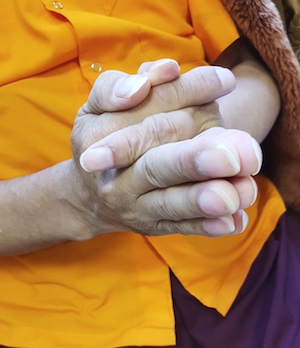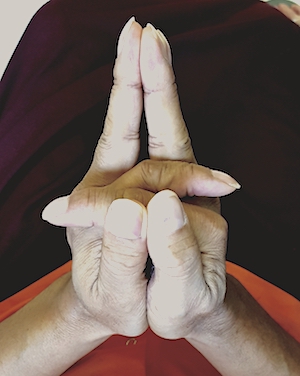Lerab Ling, 21 July 2015
An hour after his customary daily “pep talk” during a Chime Phakmé Nyingtik drupchen, Rinpoche seized the opportunity to point out to all the practitioners gathered in Lerab Ling’s majestic temple – Palri Pema Ösel Dargyé Ling – just how important it is for Vajrayana practitioners to perform the mudra that accompanies the Inexpressible Ultimate Confession (Yeshe Kuchok).
There’s something else that I need to say to you westerners: you have spent too much time studying. From a very young age until quite late in life all you do is study and not much else. So unless you are specifically taught how to do something, you are unable to pick things up by looking and listening: you cannot learn by simply watching what other people do. But perhaps in your culture, just picking things up from others doesn’t work because you could end up being sued for copyright infringement.
As so many of you suffer from this learning impediment, it is no wonder that, although all the monks do the mudra for confession and fulfilment when we chant the Inexpressible Ultimate Confession (Yeshe Kuchok), not one of the westerners even attempts it! (The mudra for confession and fulfilment is when you join the tips of the middle, ring and little fingers and fold the two index fingers in front of them.)
The practices we are doing – Vajrayana practices – involve deity, mantra, mudra and samadhi and that means that we have to perform many mudras. When we do mudra, our right hands represent the aspect of skilful means and the buddhas of the five families, and our left hands represent the aspect of wisdom and the female buddhas of the five families. The tips of the fingers on our right hands are marked by the seed syllables of the male buddhas (om hung tram hrih ha), and the tips of our left-hand fingers are marked with mum lam pam mam tam, the seed syllables of the female buddhas. The Secret Essence Tantra explains that, for example, the syllable om must meet the syllable hung in one mudra, and that mum and tam are joined in another. This tantra also explains how to form mudras by raising one finger and leaving the others folded, or by raising two fingers and folding the others, and so on, depending on the mudra.
 Orgyen Tobgyal Rinpoche's handprint in gold paint showing the syllables of the male buddhas on the fingers of the right hand (from left to right ah tram om hung and hrih) and female buddhas on the fingers of the left hand (from left to right pam lam mum mam tam).
Orgyen Tobgyal Rinpoche's handprint in gold paint showing the syllables of the male buddhas on the fingers of the right hand (from left to right ah tram om hung and hrih) and female buddhas on the fingers of the left hand (from left to right pam lam mum mam tam).
 The mudra of confession
The mudra of confessionThis particular mudra – for confession and fulfilment – is performed as a way of acknowledging our faults, broken vows and promises, which we must purify through confession practice[1]Tulku Thondup explained that, “though widely used, ‘confession’ might not be the most appropriate name for this practice. In the past, I have translated the Tibetan shakpa as confession but actually, the meaning of confession is the admission of misconduct, followed by regret for faults committed, and is only one of the four powers necessary for this practice. The four powers are the power of support, the power of regret, the power of resolution or pledge, and the power of the action, the antidote (the actual meditation of purification). The second power, the power of regret, is, I think, confession. Therefore “purification” might be better for this shakpa practice, as both purification and shakpa cover all four powers, which include the cleansing of all impurities through the flow of nectar in Vajrasattva practice. In common terms, outside Dharma language, shakpa can mean cleaning dirt or sweeping away dust.”. We make this mudra to indicate that we have broken promises and vows and that we know we are at fault.
As I’ve already said, all the monks do this mudra, but not a single one of you westerners has watched what they were doing or tried to emulate them. That’s why I started out by saying that, unless you are taught something directly, you are unable to learn. And that’s why I’m now telling you how to do this practice. If a glass of water is placed in front of a westerner, you won’t drink until you have first asked permission, “Can I drink the water?” If there is no one to ask, you won’t drink. It looks to me as though your lives are such that you have never been allowed to look at someone else and copy what they do; that’s why you don’t do the mudras.
The basis of all mudras is to join our two hands so that the tips of our fingers touch and all the male and female deities unite. This is the basis from which an inconceivable array of other mudras unfolds.
Similarly, the basis or ground of all deities is Samantabhadra. Samantabhadra is the basis from which infinite buddha manifestations spring, such as the buddhas of the five families. The syllable a is the basis from which all other sounds and mantras manifest – all vowel, consonants and expressions arise from a. Samadhis begin with the samadhi of suchness which is the source from which the infinite methods for directing the practice emanates. And each method is done at a specific and appropriate point in the practice.
Today, I have had to tell you that you should do this mudra when you recite the Inexpressible Ultimate Confession. How many years have we been coming here to Lerab Ling? How many times have you seen the monks do this mudra during the practice? Yet, not one of you has looked at what they were doing and done it yourself.
This mudra is not specific to the Inexpressible Ultimate Confession, it is a general mudra for use during confession and purification. We do it because we inevitably make mistakes during practice – including in the mudras we perform – and therefore need to purify those mistakes through confession practice. Since you cannot use your eyes to see what's happening around you, I felt I had to tell you directly that you should do this mudra to purify the mistakes you make when you perform mudras.
Translated by Gyurmé Avertin
Edited by Janine Schultz
